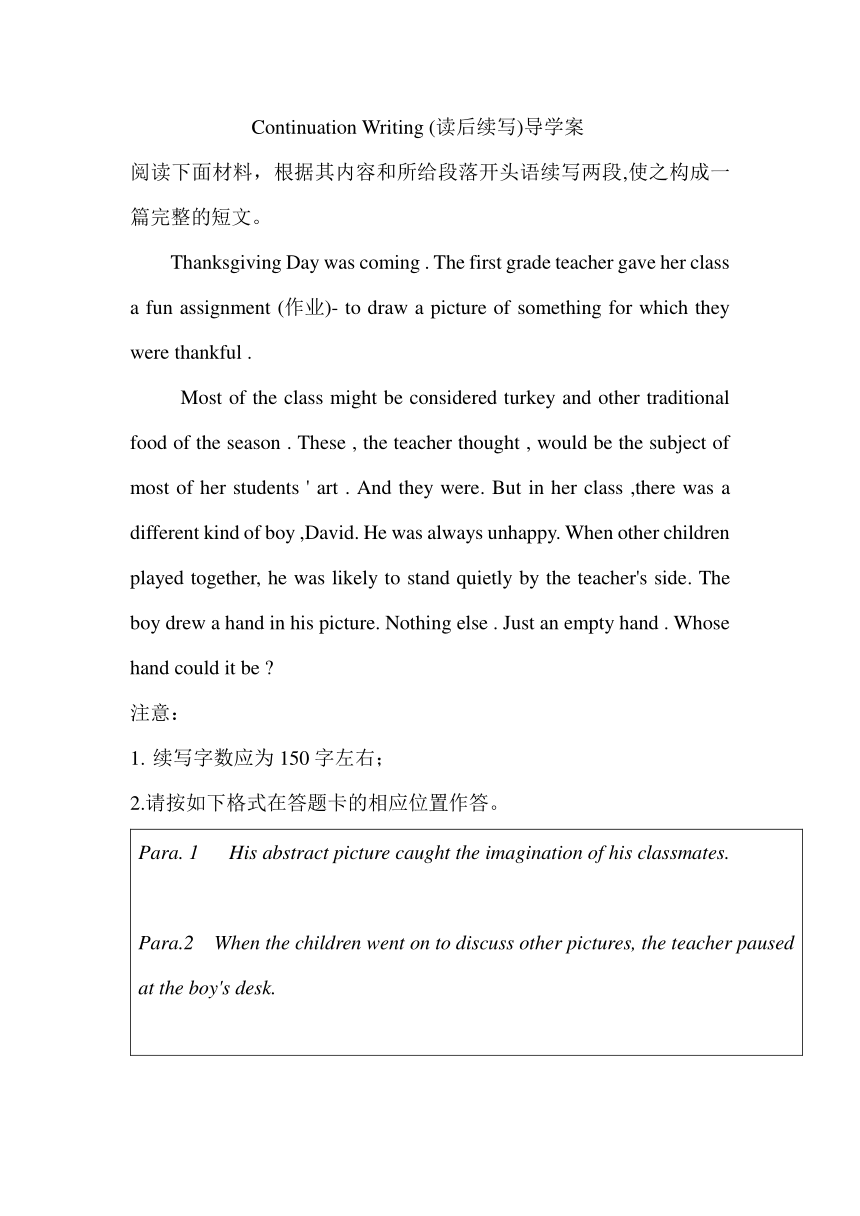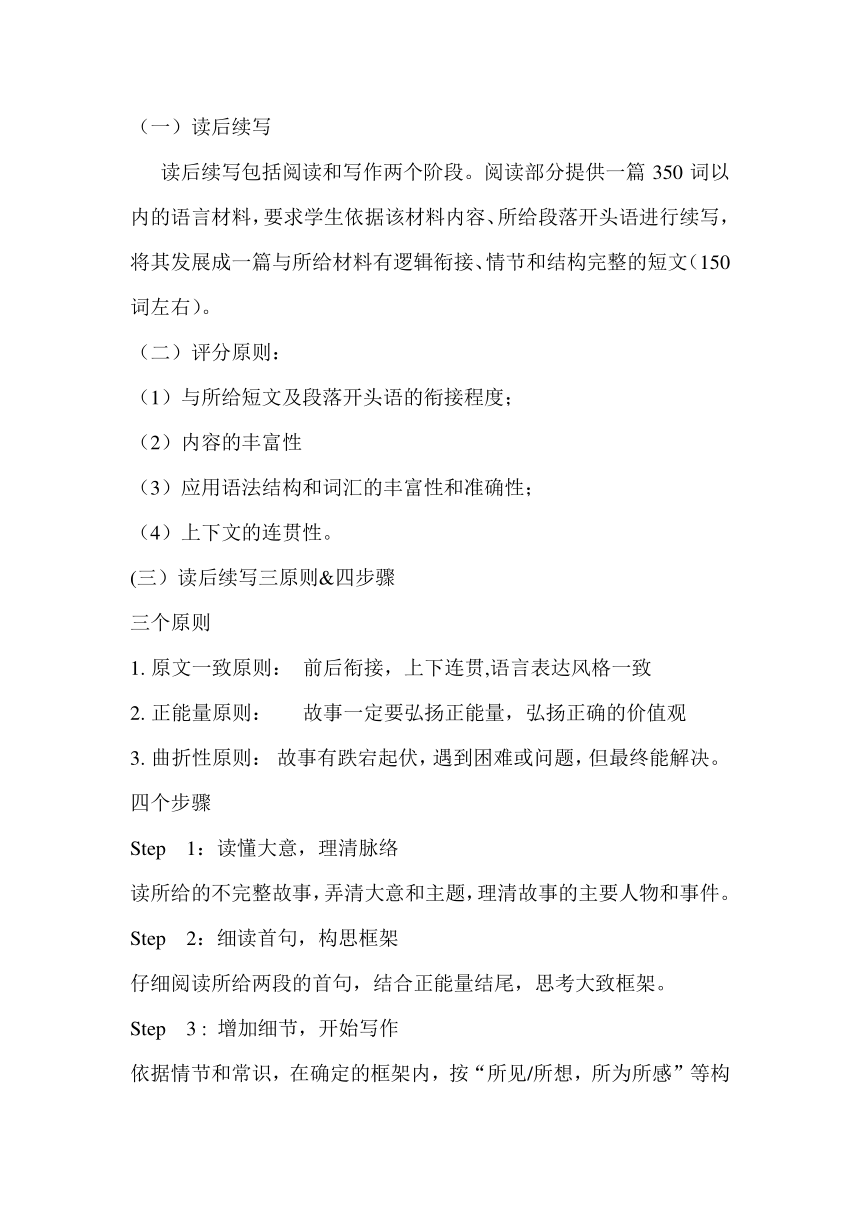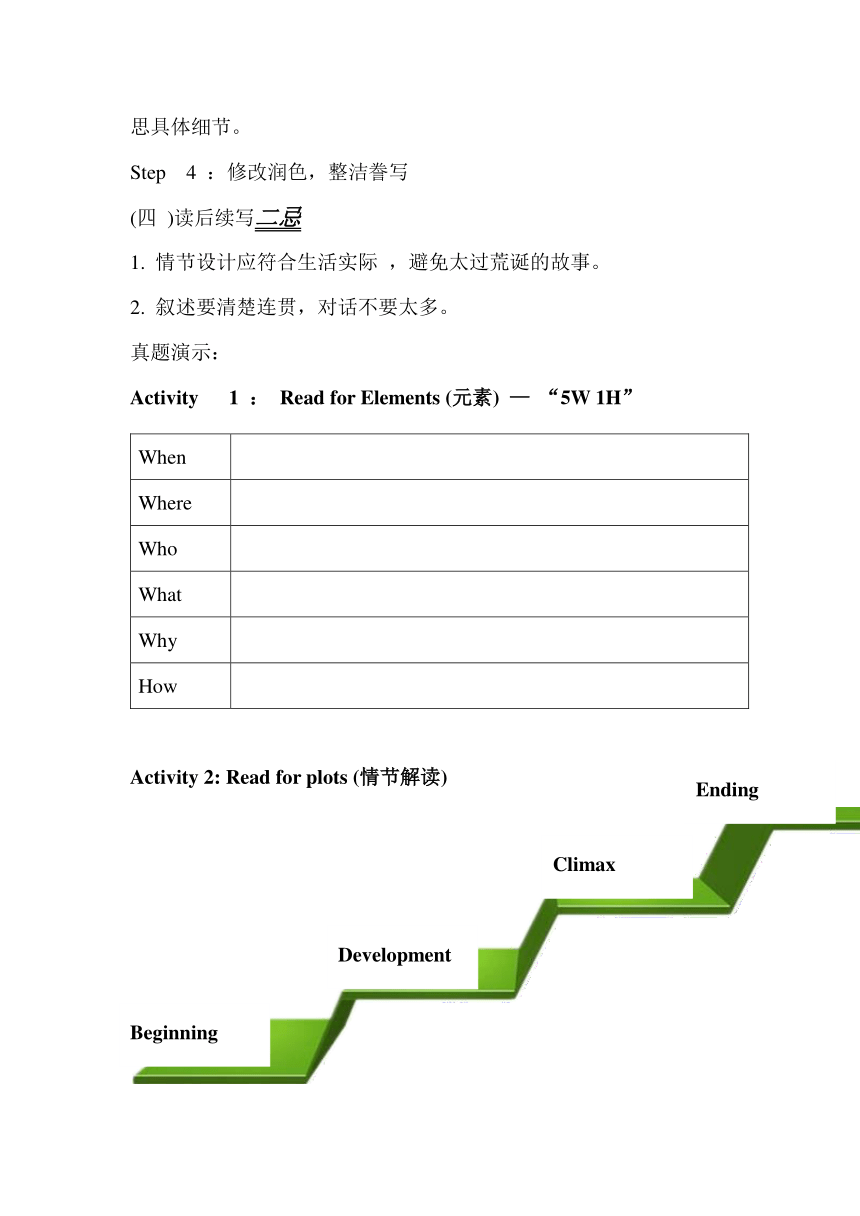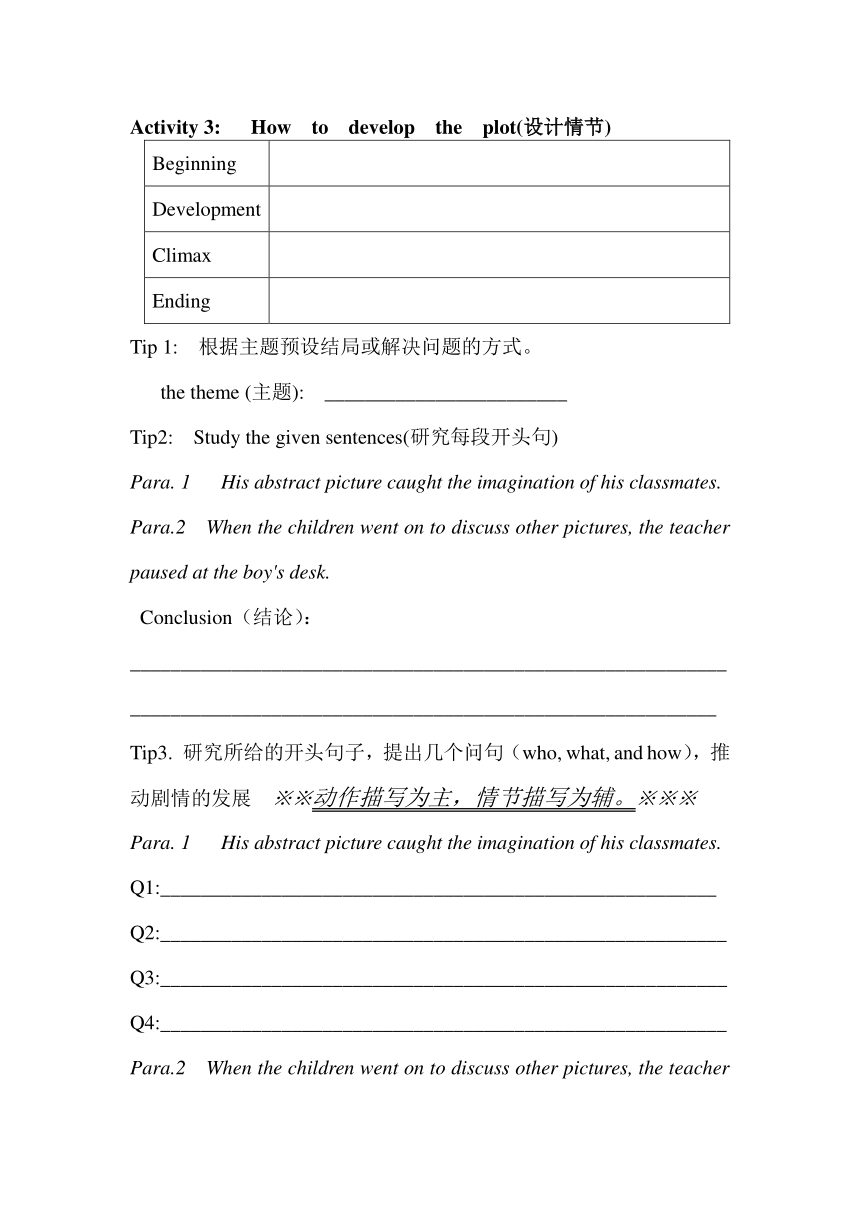读后续写Continuation Writing 导学案(无答案)-2025届高三英语复习
文档属性
| 名称 | 读后续写Continuation Writing 导学案(无答案)-2025届高三英语复习 |  | |
| 格式 | docx | ||
| 文件大小 | 129.8KB | ||
| 资源类型 | 教案 | ||
| 版本资源 | 人教版(2019) | ||
| 科目 | 英语 | ||
| 更新时间 | 2025-01-18 11:01:52 | ||
图片预览




文档简介
Continuation Writing (读后续写)导学案
阅读下面材料,根据其内容和所给段落开头语续写两段,使之构成一篇完整的短文。
Thanksgiving Day was coming . The first grade teacher gave her class a fun assignment (作业)- to draw a picture of something for which they were thankful .
Most of the class might be considered turkey and other traditional food of the season . These , the teacher thought , would be the subject of most of her students ' art . And they were. But in her class ,there was a different kind of boy ,David. He was always unhappy. When other children played together, he was likely to stand quietly by the teacher's side. The boy drew a hand in his picture. Nothing else . Just an empty hand . Whose hand could it be
注意:
续写字数应为150字左右;
2.请按如下格式在答题卡的相应位置作答。
Para. 1 His abstract picture caught the imagination of his classmates. Para.2 When the children went on to discuss other pictures, the teacher paused at the boy's desk.
(一)读后续写
读后续写包括阅读和写作两个阶段。阅读部分提供一篇350词以内的语言材料,要求学生依据该材料内容、所给段落开头语进行续写,将其发展成一篇与所给材料有逻辑衔接、情节和结构完整的短文(150词左右)。
(二)评分原则:
(1)与所给短文及段落开头语的衔接程度;
(2)内容的丰富性
(3)应用语法结构和词汇的丰富性和准确性;
(4)上下文的连贯性。
(三)读后续写三原则&四步骤
三个原则
原文一致原则: 前后衔接,上下连贯,语言表达风格一致
正能量原则: 故事一定要弘扬正能量,弘扬正确的价值观
曲折性原则: 故事有跌宕起伏,遇到困难或问题,但最终能解决。
四个步骤
Step 1:读懂大意,理清脉络
读所给的不完整故事,弄清大意和主题,理清故事的主要人物和事件。
Step 2:细读首句,构思框架
仔细阅读所给两段的首句,结合正能量结尾,思考大致框架。
Step 3 : 增加细节,开始写作
依据情节和常识,在确定的框架内,按“所见/所想,所为所感”等构思具体细节。
Step 4 :修改润色,整洁誊写
(四 )读后续写二忌
1. 情节设计应符合生活实际 ,避免太过荒诞的故事。
2. 叙述要清楚连贯,对话不要太多。
真题演示:
Activity 1 : Read for Elements (元素) — “5W 1H”
When
Where
Who
What
Why
How
Activity 2: Read for plots (情节解读)
Beginning
Development
Climax
Ending
Activity 3: How to develop the plot(设计情节)
Tip 1: 根据主题预设结局或解决问题的方式。
the theme (主题): ________________________
Tip2: Study the given sentences(研究每段开头句)
Para. 1 His abstract picture caught the imagination of his classmates.
Para.2 When the children went on to discuss other pictures, the teacher paused at the boy's desk.
Conclusion(结论):
_____________________________________________________________________________________________________________________
Tip3. 研究所给的开头句子,提出几个问句(who, what, and how),推动剧情的发展 ※※动作描写为主,情节描写为辅。※※※
Para. 1 His abstract picture caught the imagination of his classmates.
Q1:_______________________________________________________Q2:________________________________________________________Q3:________________________________________________________Q4:________________________________________________________
Para.2 When the children went on to discuss other pictures, the teacher paused at the boy's desk.
Q1:______________________________________________________
Q2:________________________________________________________Q3:________________________________________________________Q4:________________________________________________________
Tip4. 借助动作描写,心理描写,有效对话,场景描写让续写内容生动形象化。※※※叙述要清楚连贯,对话不要太多※※※
情感: _________________________________________________
动作:__________________________________________________
说:___________________________________________________
学以致用: 用思维导图画出续写故事的情节。
下水作文:
His abstract picture caught the imagination of his classmates. _________________________________________________________________________________________________________________________________________________________________________________________________________________________________________________________________________________________________________________________________________________________________
________________________________________________________________________________________________________________________________________________________________________________________________________________________________________
When the children went on to discuss other pictures, the teacher paused at the boy's desk. _______________________________________
_____________________________________________________________________________________________________________________________________________________________________________________________________________________________________________________________________________________________________________________________________________________________________________________________________________________________
___________________________________________________________
参考范文:
His abstract picture caught the imagination of his classmates. Whose hand could it be One child said that David had drawn an artist's hand, because artists draw greeting cards. Another said it was a police officer's hand, because the police protect and help people. Still others guessed it was a hand of parents, for they give happiness to children. The discussion continued until the teacher almost forgot the young artist himself.
When the children went on to discuss other pictures, the teacher paused at the boy's desk. She asked David whose hand in the picture it was. The little boy whispered, "It's yours, teacher.” He remembered the time when she stayed quietly with him. He continued ,“ Whenever I got into trouble, you always gave me a hand. I'm full of thankfulness for your help." The teacher felt moved after listening to David's words. She touched David's head and continued to work with the tears welling up in her eyes.
阅读下面材料,根据其内容和所给段落开头语续写两段,使之构成一篇完整的短文。
Thanksgiving Day was coming . The first grade teacher gave her class a fun assignment (作业)- to draw a picture of something for which they were thankful .
Most of the class might be considered turkey and other traditional food of the season . These , the teacher thought , would be the subject of most of her students ' art . And they were. But in her class ,there was a different kind of boy ,David. He was always unhappy. When other children played together, he was likely to stand quietly by the teacher's side. The boy drew a hand in his picture. Nothing else . Just an empty hand . Whose hand could it be
注意:
续写字数应为150字左右;
2.请按如下格式在答题卡的相应位置作答。
Para. 1 His abstract picture caught the imagination of his classmates. Para.2 When the children went on to discuss other pictures, the teacher paused at the boy's desk.
(一)读后续写
读后续写包括阅读和写作两个阶段。阅读部分提供一篇350词以内的语言材料,要求学生依据该材料内容、所给段落开头语进行续写,将其发展成一篇与所给材料有逻辑衔接、情节和结构完整的短文(150词左右)。
(二)评分原则:
(1)与所给短文及段落开头语的衔接程度;
(2)内容的丰富性
(3)应用语法结构和词汇的丰富性和准确性;
(4)上下文的连贯性。
(三)读后续写三原则&四步骤
三个原则
原文一致原则: 前后衔接,上下连贯,语言表达风格一致
正能量原则: 故事一定要弘扬正能量,弘扬正确的价值观
曲折性原则: 故事有跌宕起伏,遇到困难或问题,但最终能解决。
四个步骤
Step 1:读懂大意,理清脉络
读所给的不完整故事,弄清大意和主题,理清故事的主要人物和事件。
Step 2:细读首句,构思框架
仔细阅读所给两段的首句,结合正能量结尾,思考大致框架。
Step 3 : 增加细节,开始写作
依据情节和常识,在确定的框架内,按“所见/所想,所为所感”等构思具体细节。
Step 4 :修改润色,整洁誊写
(四 )读后续写二忌
1. 情节设计应符合生活实际 ,避免太过荒诞的故事。
2. 叙述要清楚连贯,对话不要太多。
真题演示:
Activity 1 : Read for Elements (元素) — “5W 1H”
When
Where
Who
What
Why
How
Activity 2: Read for plots (情节解读)
Beginning
Development
Climax
Ending
Activity 3: How to develop the plot(设计情节)
Tip 1: 根据主题预设结局或解决问题的方式。
the theme (主题): ________________________
Tip2: Study the given sentences(研究每段开头句)
Para. 1 His abstract picture caught the imagination of his classmates.
Para.2 When the children went on to discuss other pictures, the teacher paused at the boy's desk.
Conclusion(结论):
_____________________________________________________________________________________________________________________
Tip3. 研究所给的开头句子,提出几个问句(who, what, and how),推动剧情的发展 ※※动作描写为主,情节描写为辅。※※※
Para. 1 His abstract picture caught the imagination of his classmates.
Q1:_______________________________________________________Q2:________________________________________________________Q3:________________________________________________________Q4:________________________________________________________
Para.2 When the children went on to discuss other pictures, the teacher paused at the boy's desk.
Q1:______________________________________________________
Q2:________________________________________________________Q3:________________________________________________________Q4:________________________________________________________
Tip4. 借助动作描写,心理描写,有效对话,场景描写让续写内容生动形象化。※※※叙述要清楚连贯,对话不要太多※※※
情感: _________________________________________________
动作:__________________________________________________
说:___________________________________________________
学以致用: 用思维导图画出续写故事的情节。
下水作文:
His abstract picture caught the imagination of his classmates. _________________________________________________________________________________________________________________________________________________________________________________________________________________________________________________________________________________________________________________________________________________________________
________________________________________________________________________________________________________________________________________________________________________________________________________________________________________
When the children went on to discuss other pictures, the teacher paused at the boy's desk. _______________________________________
_____________________________________________________________________________________________________________________________________________________________________________________________________________________________________________________________________________________________________________________________________________________________________________________________________________________________
___________________________________________________________
参考范文:
His abstract picture caught the imagination of his classmates. Whose hand could it be One child said that David had drawn an artist's hand, because artists draw greeting cards. Another said it was a police officer's hand, because the police protect and help people. Still others guessed it was a hand of parents, for they give happiness to children. The discussion continued until the teacher almost forgot the young artist himself.
When the children went on to discuss other pictures, the teacher paused at the boy's desk. She asked David whose hand in the picture it was. The little boy whispered, "It's yours, teacher.” He remembered the time when she stayed quietly with him. He continued ,“ Whenever I got into trouble, you always gave me a hand. I'm full of thankfulness for your help." The teacher felt moved after listening to David's words. She touched David's head and continued to work with the tears welling up in her eyes.
